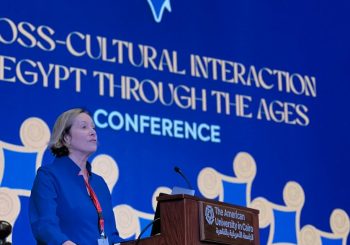The Monastery of Saint Mina stands as one of the most revered sites in Egypt’s Coptic Orthodox tradition, uniting ancient Christian origins, architectural revival, and a living tradition of pilgrimage and prayer.
Amid the arid expanse of the Mariut Desert southwest of Alexandria, near Wadi El-Natrun, lies the serene United Nations Educational, Scientific and Cultural Organization (UNESCO) World Heritage Site. Drawing pilgrims and scholars alike, its origins trace back to the formative era of early Christianity in Egypt, between the first and fourth centuries.
Known locally as Deir Mar Mina, the monastery resonates with spiritual and historical significance. Cherished for its association with miracles and its deep-rooted place in Coptic devotion, the complex serves as a sacred site and an enduring legacy of Coptic tradition. Rebuilt during a 20th-century revival, the monastery’s distinctive desert architecture and active monastic life bridge antiquity and the present.
A Pilgrimage Through Time
The tale of Saint Mina, after whom the monastery is named, dates to the fourth century, when Christians, guided by visions and miraculous signs, buried the martyred soldier’s remains.
Centuries of veneration followed, with legend recounting miraculous healings, among them the story of a sick lamb, once stricken with sheep scab, that was instantly cured after collapsing on the ground. Soon, people who lay at that very spot began recovering from their own ailments, making the site one of the ancient world’s most sought-after destinations for Christian pilgrims.
By the late Roman period, in the fifth century, the town of Abu Mena had developed around the tomb of the martyred Saint Mina, becoming a Christian pilgrimage center that had been attracting visitors from across the Mediterranean.
In the 20th century, archaeologists unearthed distinctive clay flasks bearing the saint’s image. The artifacts are now held in locations as far afield as Germany, Italy, and Jerusalem, as a reminder of the sacred home of Mina the Wonderworker.
Tragically, both the town and its cathedral suffered destruction in the wake of the Arab conquest in the seventh century, leading to centuries of decline.
Yet the site’s holy reputation endured, and the ruins were eventually enshrined as a UNESCO site in 1979, recognized for both spiritual and archaeological significance.
Revival in the Desert
The twentieth century saw a revival led by Pope Cyril VI, who in 1959, laid the foundation stone for a new monastery and cathedral near the ancient remains. The site extends across roughly one square kilometer and features the remains of a church, several monastic structures, public buildings, and workshops.
The modern complex is a remarkable example of early Christian monastic and pilgrimage architecture, defined by an artistic style that blends Egyptian design with Mediterranean and Anatolian influences.
An example of Mediterranean influence is the basilica, a rectangular church with a central hall flanked by side aisles and rows of columns, blending elements inspired by ancient Egyptian temple design, along with features characteristic of Roman and Byzantine architecture common throughout the region. Anatolian influence is evident in the presence of Scythian ampullae, which are small containers used to carry sacred items from Abu Mena and Anatolia.
That distinctive blend comes to life in the whitewashed walls, typical of desert architecture, and in domed chapels adorned with delicate ornamentation. Surrounding the main cathedral, decorated with Coptic iconography and evoking the style of early Christian basilicas, stand monastic cells, a guesthouse, and welcoming spaces for pilgrims.
A Living Heritage
Today, the Monastery of Saint Mina remains a center of Coptic spiritual life, home to a monastic community dedicated to prayer, hospitality, and service. Pilgrims visit year-round to venerate the relics of Saint Mina and Pope Cyril VI, especially during the feasts of the saint’s martyrdom in November and the church’s consecration in June. The monastery continues to uphold Egypt’s Coptic heritage through both tradition and renewal.
Beyond its spiritual draw, the Monastery of Saint Mina stands as a symbol of Coptic resilience and continuity, linking Egypt’s ancient past with its living faith and cultural identity.







Comments (0)